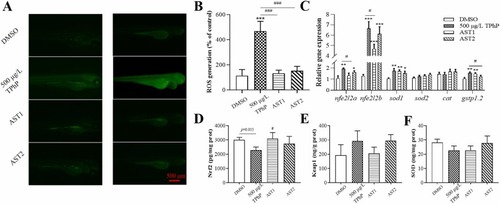Fig. 5
- ID
- ZDB-FIG-240408-29
- Publication
- Zhang et al., 2024 - Astaxanthin activates the Nrf2/Keap1/HO-1 pathway to inhibit oxidative stress and ferroptosis, reducing triphenyl phosphate (TPhP)-induced neurodevelopmental toxicity
- Other Figures
- All Figure Page
- Back to All Figure Page
|
The level/activity of oxidative stress biomarkers affected by TPhP can be partially rescued by astaxanthin (AST). (A) The ROS production and apoptotic signals were measured in TPhP and astaxanthin + TPhP-treated zebrafish embryos. (B) Quantitative analysis of ROS generation. (C) The expression of oxidative stress-related genes in zebrafish after 96 hpf exposure to each group. (D-F) The levels of Nrf2, Keap1 and SOD of zebrafish exposed to each group for 96 hpf. AST1 is the abbreviation for TPhP (500 μg/L) + AST (30 nM) and AST2 is the abbreviation for TPhP (500 μg/L) + AST (100 nM). The treatment groups were composed of three replicates, each containing 25 larvae. Values represent mean ± SEM. In comparison with the control group, * p < 0.05, * * p < 0.01, * ** p < 0.001. Compared with 500 μg/L group, # p < 0.05, ### p < 0.001 (one-way ANOVA and LSD test was employed). |

